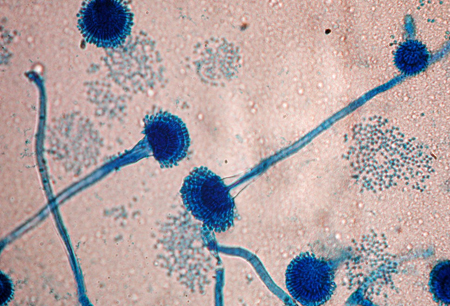Summary
Definition
History and exam
Key diagnostic factors
- pleuritic chest pain
- pleural rub
- nasal ulcer
- skin rash
Other diagnostic factors
- cough
- headache
- fever
- congestion or sinus tenderness
- hemoptysis
- dyspnea
- facial pain
- seizure
- altered mental status
- cranial nerve palsy
- malaise
- weight loss
Risk factors
- allogeneic stem cell transplantation
- prolonged severe neutropenia (>10 days)
- use of immunosuppressive therapy
- chronic granulomatous disease (CGD)
- solid organ transplantation (SOT)
- acute leukemia
- aplastic anemia
- prior or current lung disease
- advanced chronic lung disease
- influenza infection
- COVID-19 infection
- primary immunodeficiency
- HIV infection
- diabetes mellitus
- cystic fibrosis
- severe burns
- malnutrition
- multiple myeloma
- immunocompetent patients
- age >55 years
- smoking
Diagnostic tests
1st tests to order
- CXR
- high-resolution chest CT scan
- high-resolution sinuses CT scan
- high-resolution brain CT scan
- MRI sinuses
- MRI brain
- serum Aspergillus galactomannan (GM) antigen by enzyme immunoassay (EIA)
- sputum culture
- sputum smear
Tests to consider
- BAL Aspergillus galactomannan (GM) antigen
- bronchoscopy with bronchoalveolar lavage (BAL) fungal stain
- bronchoscopy with BAL fungal culture
- polymerase chain reaction
- serum (1-3)-beta-D-glucan
- serum Aspergillus IgG
- tissue biopsy
- tissue fungal culture
- tissue fungal stain
Treatment algorithm
suspected invasive aspergillosis
confirmed invasive aspergillosis
aspergilloma with life-threatening hemoptysis
chronic pulmonary aspergillosis
Contributors
Authors
Mayur Ramesh, MD

Senior Consultant
Division of Infectious Diseases
Henry Ford Hospital
Detroit
MI
Disclosures
MR declares that he has no competing interests.
Pranatharthi Chandrasekar, MD

Professor
Division of Infectious Diseases
Wayne State University
Detroit
MI
Declarações
PC is an author of references cited in this topic.
Revisores
Daniel Friedman, MD
Assistant Professor of Medicine
Section of Infectious Diseases and Global Health
University of Chicago
Chicago
IL
Declarações
DM declares that he has no competing interests.
Paul Verweij, MD
Professor of Medical Microbiology
Department of Medical Microbiology
Radboud University
Nijmegen
The Netherlands
Declarações
Not disclosed.
Changa Kurukularatne, MD
Attending Physician/Consultant
Ochsner Medical Center
Department of Infectious Diseases
New Orleans
LO
Declarações
CK is a member of the Speakers Bureau for Pfizer Inc., the manufacturer of voriconazole and anidulafungin.
Créditos aos pareceristas
Os tópicos do BMJ Best Practice são constantemente atualizados, seguindo os desenvolvimentos das evidências e das diretrizes. Os pareceristas aqui listados revisaram o conteúdo pelo menos uma vez durante a história do tópico.
Declarações
As afiliações e declarações dos pareceristas referem--se ao momento da revisão.
Referências
Principais artigos
Barnes PD, Marr KA. Aspergillosis: spectrum of disease, diagnosis, and treatment. Infect Dis Clin North Am. 2006 Sep;20(3):545-61, Resumo
Patterson TF, Thompson GR 3rd, Denning DW, et al. Practice guidelines for the diagnosis and management of aspergillosis: 2016 update by the Infectious Diseases Society of America. Clin Infect Dis. 2016 Aug 15;63(4):e1-e60.Texto completo Resumo
Denning DW, Cadranel J, Beigelman-Aubry C, et al. Chronic pulmonary aspergillosis: rationale and clinical guidelines for diagnosis and management. Eur Respir J. 2016 Jan;47(1):45-68.Texto completo Resumo
Kosmidis C, Denning DW. The clinical spectrum of pulmonary aspergillosis. Thorax. 2015 Mar;70(3):270-7.Texto completo Resumo
Ullmann AJ, Aguado JM, Arikan-Akdagli S, et al. Diagnosis and management of Aspergillus diseases: executive summary of the 2017 ESCMID-ECMM-ERS guideline. Clin Microbiol Infect. 2018 May;24 Suppl 1:e1-e38.Texto completo Resumo
Hope WW, Walsh TJ, Denning DW. Laboratory diagnosis of invasive aspergillosis. Lancet Infect Dis. 2005 Oct;5(10):609-22. Resumo
Maghrabi F, Denning DW. The management of chronic pulmonary aspergillosis: the UK National Aspergillosis Centre approach. Curr Fungal Infect Rep. 2017;11(4):242-51.Texto completo Resumo
Limper AH, Knox KS, Sarosi GA, et al; American Thoracic Society Fungal Working Group. An official American Thoracic Society statement: Treatment of fungal infections in adult pulmonary and critical care patients. Am J Respir Crit Care Med. 2011 Jan 1;183(1):96-128.Texto completo Resumo
Artigos de referência
Uma lista completa das fontes referenciadas neste tópico está disponível para os usuários com acesso total ao BMJ Best Practice.

Diagnósticos diferenciais
- Mucormycosis and other zygomycoses (e.g., phycomycosis, basidiobolomycosis)
- Fusariosis
- Scedosporiosis
Mais Diagnósticos diferenciaisDiretrizes
- Revision and update of the consensus definitions of invasive fungal disease
- Microbiological laboratory testing in the diagnosis of fungal infections in pulmonary and critical care practice
Mais DiretrizesConectar-se ou assinar para acessar todo o BMJ Best Practice
O uso deste conteúdo está sujeito ao nosso aviso legal